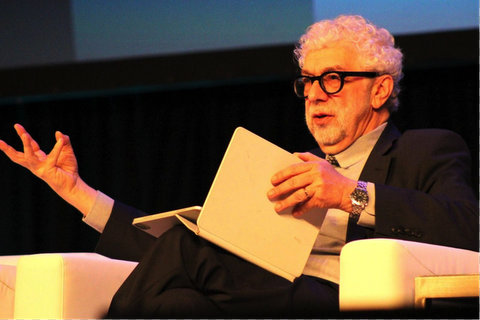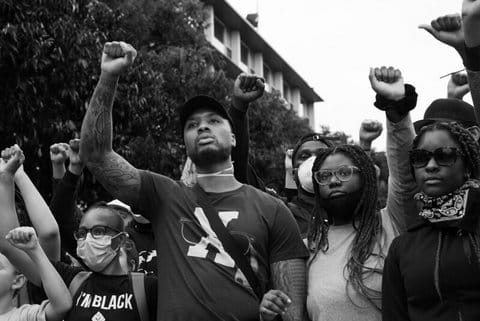
14 Jul Eliminating Hate Not Realistic, But Limiting It Is, Experts Say

“The idea that you can eradicate hate is preposterous,” said Misha Galperin, CEO of the National Museum of American Jewish History, at the 2023 Eradicate Hate Global Summit. (Joe Porrello / The CC Pulse)
Editor’s note: The Eradicate Hate Global Summit began in 2021 in response to the mass shooting at the Tree of Life synagogue. Last year, The CC Pulse was there for the first time in service of our Stop the Hate coverage.
By Joe Porrello
PITTSBURGH — Human rights activist Natan Sharansky has seen a great deal of hate. He believes it cannot be completely exterminated — and perhaps shouldn’t be.
For nine years, he was a prisoner in a labor camp in the brutal Soviet Gulag. He has spent decades working for human rights. Now, he is chair of the Combat Antisemitism Movement and the Institute For the Study Of Global Antisemitism and Policy.
While working to rescue thousands of Ethiopian-born Jews — who Cultural Survival labeled in 2010 “the most threatened Jewish community in the world” — Sharansky met Misha Galperin, a fellow Ukrainian-born Jew who sees hate as part of a necessary balance.
They discussed their perspective in conversation at the 2023 Eradicate Hate Global Summit.
“The idea that you can eradicate hate is preposterous,” said Galperin, CEO of the National Museum of American Jewish History. “In fact, some might say that it’s not necessarily such a good thing.”
He said Jewish tradition teaches that humans have two motives: yetzer ha-tov (inclination to do good) and yetzer ha-ra (inclination to do evil).
“The two must coexist or be in dialect with each other in order for a human being to survive in the world,” he said.
Sharansky spoke at the summit and in his first book, “Fear No Evil,” about being arrested, put on trial and imprisoned for trying to help Jews wanting to leave the Soviet Union. As a prisoner, he says playing chess in his head helped him survive the harsh conditions. After his release, Sharansky moved to Israel, where he devoted himself to improving the human condition through activism and won the country’s highest honor — the Israel Prize.
“In Israel, he became a hero,” said summit board member David Shapiro, who has worked with Sharansky on multiple occasions.
>>>Read: Learning From the Past Can Help Stop Hate and Promote Healing, Activists Say<<<
Sharansky says hate has always been prevalent — dating back to ancient Israel, Greece, Egypt or Rome.
“There was not such a society where it didn’t exist,” he said.
Galperin said hate is often a subconscious driver for success and achievement. However, it also begets bias-fueled violence and harassment.
But love is not possible without hate, says Galperin, who holds a doctorate in clinical psychology. He pointed to the theories of Sigmund Freud, who said love and hate are both rooted in aggression and interwoven because one can easily lead to the other. According to Freud, innate hate in humans is moderated by rationality and morality, noted Galperin.
According to Galperin, humans have a tendency to form social groups with different customs and languages, but this can lead to what psychoanalyst Erik Erikson called “pseudospeciation,” in which people view those in other groups as a different species.
“That tendency… is what is necessary often for human beings to define who they are,” Galperin said. “Having an enemy is as important as having those to identify with, but, of course, none of us here would condone the idea that hatred and evil should reign; we need to figure out ways of preventing it and channeling it in the appropriate ways.”
Sharansky and Galperin agree expressions of hate around the world can be lessened by people of different cultures, faiths and political views coming closer together instead of moving apart ideologically and emotionally.
“We live in an age where it seems the differences among people, or the polarization, is becoming a true epidemic,” Galperin said.
>>>Read: Panel Discusses Building Bridges in a Time of Increased Hate and Polarization<<<
Engaging in silos of thought with less diverse contacts on social media adds to polarization, but it all begins with politics, says Sharansky. He pointed to many Republicans and Democrats not speaking to each other and saying the opposite group is the hateful one.
>>>Read: ‘License to Hate’: Political Leaders, Misinformation Key Contributors to Bigotry, Veteran Journalist Says<<<
To avoid negativity like bigotry and violence, Sharansky said it is paramount not to let hate destroy the “other’s” humanity. He says while in the Gulag, people he trusted and relied on had strong feelings of roots, identity, self-confidence and freedom and did not hate the other. “They respect the other; they need the other.”
Meeting people from all walks of life helps one avoid generalizing while also developing appreciation and empathy for others, says Galperin.
“We know from psychological research that it’s a lot easier to hate groups of people than individuals,” he said.
Humans with opposing viewpoints finding common ground can help curb hate, says Sharansky.
According to Sharansky and Galperin, recognizing the roots of hate and nipping them in the bud will keep it from growing into something detrimental. But displacing the roots altogether may not be as successful.
“The thing is not how to eradicate hate but how not to empower hate,” said Sharansky.
This resource is supported in whole or in part by funding provided by the State of California, administered by the California State Library in partnership with the California Department of Social Services and the California Commission on Asian and Pacific Islander American Affairs as part of the Stop the Hate program. To report a hate incident or hate crime and get support, go to CA vs Hate.





No Comments